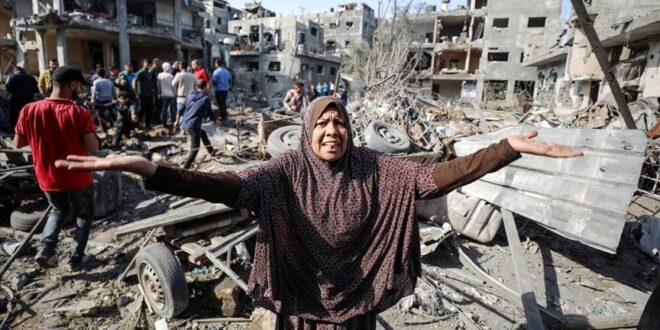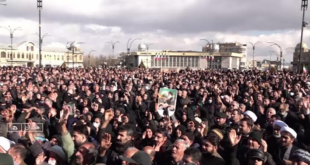On June 19, the UN High Commissioner for Human Rights published a report according to which “the Israel Defense Forces may not distinguish between civilians and terrorists.” In fact, we are talking about accusations of war crimes, namely, the IDF’s deliberate killing of civilians in Gaza. But given that Hamas terrorists fight in civilian clothes without insignia, determining the real ratio of civilians to militants among the dead becomes an incredibly difficult task. Israeli journalist Vitaly Novoselov analyzes verifiable facts about the deaths of civilians and comes to the conclusion: for military conflicts in densely populated areas, the proportion of civilians among the dead in Gaza is more likely to be smaller than larger, and, given Hamas’s terrorist tactics, it is impossible to avoid the deaths of civilians.
The UN High Commissioner’s assumption is based on an analysis of six attacks by the Israel Defense Forces that resulted in heavy civilian casualties in the Gaza Strip and the destruction of civilian infrastructure. “It cannot be ruled out that Israeli forces systematically violated the rules of war by reacting disproportionately and without due caution,” the document says.
“Disproportionate” release of hostages
Disproportionate attacks include Operation Arnon , which freed four Israeli hostages on June 8 in Nuseirat. Hamas held the abductees in residential apartment buildings in the center of a densely populated area that was not under IDF control, near a market. When Israeli special forces arrived in an ordinary furniture van, stormed the buildings and killed the armed men guarding the hostages, Hamas militants began to flock to the scene of the operation and opened intense fire on the Israelis. As a result, the IDF was forced to use aircraft to isolate the special forces and the hostages and evacuate them. Of course, this also led to incidental civilian casualties.
This operation shows that Hamas’ actions make casualties inevitable. First, the very act of taking hostages forces the Israeli security forces to make every effort to free them. Second, keeping them in a densely populated area puts all its residents at risk. And third, the fierce armed resistance to the forces that came to free the abductees forced the IDF to conduct a complex military operation right in the area. Under these circumstances, it was impossible to free the abductees without causing casualties.
This is not the first UN accusation of war crimes against Israel in the eight months of the war in Gaza. In early June, UN Secretary-General Antonio Guterres for the first time blacklisted the Israel Defense Forces for killing children in war, along with Hamas, Palestinian Islamic Jihad, and both sides in the Sudanese civil war – the Sudanese army and the so-called Rapid Reaction Force (RSF).
In early June, the UN Secretary General for the first time included the IDF in the blacklist of organizations that kill children.
The UN’s accusations could have far-reaching consequences for Israel. For example, they could be taken into account when the International Court of Justice considers South Africa’s lawsuit against Israel, as well as when the International Criminal Court rules on Supreme Prosecutor Karim Khan’s request for an arrest warrant for Israeli Prime Minister Benjamin Netanyahu and Defense Minister Yoav Galant. In addition, based on the UN reports, individual countries could decide to limit economic and military cooperation with Israel, including stopping the supply of weapons and ammunition. Since early May, the United States has already delayed the supply of certain types of munitions to Israel, including precision-guided bombs weighing 900 and 225 kg, as well as 6,500 JDAM (Joint Direct Attack Munitions) kits. The reason for the delay is fears that Israel could use these munitions against civilians in the Gaza Strip.
In all of these cases, the assumption that the IDF may have committed war crimes is based on some statistics of civilian casualties in the Gaza Strip. But where do these statistics come from and can they be trusted?
Who and how counts victims in the Gaza Strip
There is only one source of information on the losses among the Gaza Strip residents during the war – this is the Gaza Health Ministry, a Hamas structure, as are all the civil authorities in the Palestinian exclave. So, according to the Gaza Health Ministry as of June 23, 37.5 thousand people died during the war in the Gaza Strip.
The Gaza Ministry of Health claims that all the dead have been identified. However, the UN Office for the Coordination of Humanitarian Affairs decided to check this and found that out of the 34,844 victims in Gaza reported at the time of publication of the report, only 24,686 were verified. At the same time, the number of minors killed in the report decreased from 14,500 (according to the UN report ) to 7,987, and the number of women killed – from 9,500 (UN report of March 1) to 4,959.
It is important that the Gaza Health Ministry statistics do not differentiate between civilians and militants. Hamas takes advantage of the fact that the Gaza Strip is not a state and officially has no armed forces, therefore, all those killed in Gaza, including Hamas militants, can be called “civilian casualties.” For this reason, immediately after the attack on Israel on October 7, Hamas militants took off their military uniforms and are fighting in civilian clothes, adding to the statistics of civilian casualties. During the war, Hamas and the IDF have published hundreds of videos from the Gaza Strip, but in none of them will you see Hamas militants in military uniform. And even those who held hostages in their homes, that is, directly engaged in terrorist activities and were liquidated during special operations, also added to the number of “civilian casualties” as a doctor and a journalist .
Hamas hides the casualties among its fighters. Nevertheless, we have some idea about them. Firstly, the same report of the UN Office for the Coordination of Humanitarian Affairs states that of the 24,686 verified victims, 10,006 (40%) were adult males who had not reached old age. It is unknown what percentage of the 7,987 minors who died were actually 15-18 year-old combatants who took up arms in military operations and were thus a legitimate target of the IDF, according to the rules of war and international law. But such combatants are also included in the number of children who died.
At the time of this publication, the IDF estimates that approximately 14,000 Hamas and other terrorist organization militants have been killed during the military operations.
Laundering Hamas Statistics
It would seem that both the significant correction of Hamas data by the UN office and the very fact that it does not contain information about combatants should become grounds for doubting the reliability of the Gaza Ministry of Health data. Not to mention the revealed facts of direct falsifications. For example, after a rocket explosion in the parking lot of the Al-Ahla hospital in Gaza on October 17, 2023, the Gaza Ministry of Health announced 500 deaths in the destroyed building. Literally the next day it turned out that the building was almost not damaged, and the explosion simply could not have killed so many people. But even after the obvious falsification of data by the Gaza Ministry of Health, this data continues to be used by the UN, international human rights organizations, and governments of various countries, including US President Joe Biden. And from all these “sources”, Hamas data in an already “laundered”, legitimate form gets into the media.
The International Institute for Social and Legal Studies (IISLS) in Israel decided to check how the world’s leading media handle data on casualties in the Gaza Strip. An analysis of publications by five media outlets – CNN, the New York Times, the Washington Post, the BBC and The Guardian – for February 2024 (the report is available to The Insider) showed that 92% of publications do not mention that combatants are among the dead in Gaza. 96% of articles with statistical data on casualties do not indicate the number of Hamas militants killed at all, although this data is published by the IDF. 78% of publications cite Hamas data, and only 4% of publications cite IDF data. The remaining articles cite data from officials and international organizations (as a rule, this is a retelling of data from the same Gaza Ministry of Health). In 20% of cases, journalists do not indicate the source of information and simply cite the data as established facts. Moreover, in all these cases, they use data from the Gaza Ministry of Health.
92% of Western media reports fail to mention that combatants are among those killed in Gaza
Not a single publication examined by IISLS mentioned that Hamas figures are unverifiable or contradictory. In contrast, nearly 4% of publications indicated that Israel’s figures are unverifiable. Given Israel’s minimal representation as a source of information, this percentage is disproportionately high.
“In none of the publications we studied did a single journalist ask the question of how many civilians actually died in Gaza. Instead, we see how the world’s leading media, willingly or unwillingly, participate in forming the narrative that Israel killed 35,000 civilians in Gaza,” IISLS research director Tatyana Glezer told The Insider.
Hamas’ Deadly Weapon
“The death of your children and other Palestinians is the blood that keeps our people alive,” wrote Hamas leader Yahya Sinwar in Gaza to Hamas political wing leader Ismail Haniyeh, whose three sons were killed by the IDF. Sinwar’s letters were recently published by The Wall Street Journal .
The correspondence makes it clear that maximizing casualties in Gaza is part of Hamas’s military strategy. The WSJ authors write that Sinwar does not even try to prevent civilian casualties. On the contrary, a large number of casualties increases criticism of the IDF’s actions in the Arab world and the West, leads to a wave of anti-Israeli protests and an anti-Israeli media campaign — all of which benefits Hamas. In one of the letters, Sinwar writes about the losses during the Algerian War of Liberation (1958–1963): “Hundreds of thousands died there, but they were necessary sacrifices.”
Using civilians as human shields is entirely consistent with this strategy. That is why Hamas uses methods such as total mining, including residential buildings, without any restrictions. In many areas of the Gaza Strip, the IDF finds explosive devices and ammunition in almost every home, sometimes in every apartment. Explosive devices and ammunition are even found in children’s closets , cribs and toys. It must be understood that civilians in Gaza remain in mined houses. We do not know how many of them died as a result of careless actions or accidental detonation of explosive devices. With such a density of mining, even the targeted elimination of terrorists using a low-yield munition in an individual apartment can lead – and in some cases has led – to the detonation of munitions in other apartments and the blowing up of entire houses.
Hamas explosive devices and ammunition are even found in children’s closets, cribs and toys
Hamas militants have been firing rockets and shelling civilians from residential areas, from windows and rooftops, from hospitals , schools , mosques, cemeteries and UN facilities . It is clear that IDF retaliatory strikes may result in civilian casualties. There have been numerous cases of Hamas preventing civilians from evacuating from the war zone after the IDF had warned them to do so. In a number of cases, Hamas militants have been reported to have opened fire on civilians. For example, on November 4 last year, Palestinian journalist Amjad Taha posted videos and photographs on his Twitter account showing the bodies of dead local residents. Taha claimed that they were killed by Hamas snipers in order to stop the flow of refugees from Gaza to the southern part of the Strip. On May 14, the IDF released unique footage from Rafah showing terrorists opening fire on Palestinian civilians who were apparently trying to receive humanitarian aid.
Finally, according to the IDF, when rockets are fired from Gaza into Israel, about 15% of the rockets either explode at launch or fall on the heads of Gazans after deviating from their trajectory. This is what happened on October 17, 2023, in the parking lot of the Al-Ahla Hospital, where an Islamic Jihad rocket exploded.
In all such cases, civilian casualties are a direct result of Hamas’ violation of the laws and customs of war.
Real Ratio of Victims
John Spencer, director of urban warfare studies at the Modern War Institute at the U.S. Military Academy at West Point, who served in the U.S. Army for 25 years and served two tours in Iraq, says Israel has taken more steps to prevent civilian deaths than any other country in urban warfare history. Spencer cites these steps: first and foremost, the use of precision-guided munitions (PGMs). Online, it’s easy to find photos from the Gaza Strip that show an IDF strike destroying one apartment in a large apartment building, as if it had been ripped from the building.
Before carrying out strikes, the IDF collected intelligence on the presence of civilians using satellite images, cellphone scanning, and other methods of observing targets. Before the officer in charge gives the order to open fire, a risk assessment for civilians is always carried out. In many cases, the attack was called off when intelligence spotted children near the target. This is why Hamas fighters often move through the streets of Gaza surrounded by children.
Finally, Spencer notes that the IDF warns the population well in advance of combined air and ground attacks, giving them time to evacuate to designated safe zones. This is done in several ways: phone calls, voice and text messages, and leaflets dropped from the air. During the war, the IDF also instituted daily four-hour humanitarian pauses to allow civilians to leave areas of active combat through safe corridors.
Another innovative measure to prevent civilian casualties was Israel’s distribution of IDF military maps and even urban battle schedules to help civilians evacuate. “No army in history has ever done this,” says John Spencer.
As a result of these unprecedented measures, the IDF was able to achieve an unprecedented combatant-to-civilian casualty ratio for wars in dense urban areas. Spencer recalls that during the American operation in Mosul in 2016-2017, about 10,000 civilians and about 4,000 Islamic State fighters were killed — 2.5:1.
In the Second Chechen War, according to official data, about 10 thousand militants were killed, while, according to Amnesty International , up to 25 thousand civilians died – 2.5:1.
During the Iraq War from 2003 to 2012, according to the Iraq Body Count project , 162,000 people were killed, of which approximately 79% were civilians – 4:1.
On May 13, in an interview with Dan Senor on the Call Me Back podcast , Israeli Prime Minister Benjamin Netanyahu gave the only rough estimate of casualties in Gaza. He said, “14,000 combatants were killed and probably about 16,000 civilians.” Even if we use the dubious Gaza Health Ministry data of 37,500 dead, the ratio is about 1.5:1. If we use the verified data from the UN Office for the Coordination of Humanitarian Affairs of 24,686 dead and compare it with Netanyahu and the IDF’s data of 14,000 fighters killed, there is less than one civilian for every combatant. For a war in a densely populated area, this is an extremely low collateral damage rate.
It is terrible when civilians die in war. But sometimes a country has no choice but to wage war to protect itself and its citizens. This is exactly the situation Israel found itself in on October 7, 2023. The war in Gaza began with a genocidal attack by Hamas that killed about 1,200 Israelis and citizens of other countries in just one day, October 7. About 800 of them were civilians. The attack was accompanied by monstrous atrocities, torture and murder of children in front of their parents and parents in front of their children, and numerous cases of sexual violence. 251 people were kidnapped and taken to Gaza. Of these, 120 remain there to this day. The genocidal attack by Hamas that began on October 7 last year is ongoing right now. And Hamas leaders have repeatedly stated that they will repeat the attacks again and again until they achieve their goal – the destruction of Israel.
Hamas leaders have repeatedly said they will repeat the attacks again and again
Israel launched a military operation in the Gaza Strip to stop Hamas, eliminate a clear and present threat to Israel, and bring home the abductees. “No army fighting an entrenched enemy in a dense urban environment barely twice the size of Washington, D.C., can avoid civilian casualties,” argues John Spencer. Of course, an army can conduct a war in different ways—maximizing collateral damage, ignoring it, or minimizing it. In Israel’s war with Hamas, the side maximizing civilian casualties is Hamas. Moreover, it cannot be ruled out that Yahya Sinwar, when he plotted the October 7 attack, intended it to provoke the most brutal Israeli retaliation. However, the IDF, as shown above, does everything it can to minimize civilian casualties.
Death is Hamas’ weapon. Using its monopoly on data and laundering it through the UN, human rights organizations and mainstream media, Hamas creates a false picture of genocide in Gaza. Paradoxically, Hamas uses genocide not only against Jews but also against its own people to achieve its goal.
 Eurasia Press & News
Eurasia Press & News




